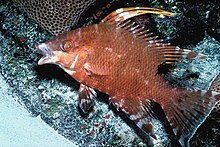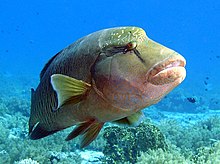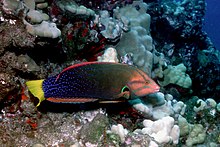Wrasse
| Wrasse | ||||||||||||
|---|---|---|---|---|---|---|---|---|---|---|---|---|

Sea peacock ( Thalassoma pavo ) |
||||||||||||
| Systematics | ||||||||||||
|
||||||||||||
| Scientific name | ||||||||||||
| Labridae | ||||||||||||
| Cuvier , 1816 |
The wrasse (Labridae) are a family of marine fish from the group of perch relatives (Percomorphaceae). Wrasses are often extraordinarily colorful and also show a great variety in size and shape. They live in the shallow, coastal waters of all oceans, especially in the tropical coral reefs , but also, with a few species, in the Mediterranean and the North Sea .
The first wrasse were scientifically described as early as 1758 by the founder of modern taxonomy , Carl von Linné , the family itself was established in 1816 by the French naturalist Georges Cuvier . The name wrasse comes from the bead-like lips, which particularly characterize the larger species ( Latin labrum "lip").
With more than 65 genera and over 500 species , they are the second largest family of marine fish after the gobies (Gobiidae) . According to recent studies, the parrotfish and the Odacids also belong to the wrasse family, which would include over 600 species.
distribution
Wrasses live worldwide in the seas of tropical, subtropical and temperate climates, always on coasts and mostly on rocky and coral reefs. No species lives pelagic in the open sea or the deep sea . The marine areas around Australia show the greatest biodiversity , where 42 genera with 165 species are at home.
In the Mediterranean and neighboring eastern Atlantic 20 species, including six species live in parts of the North Sea . The spotted wrasse ( Labrus bergylta ), the gold maid ( Symphodus melops ) and the rock perch ( Ctenolabrus rupestris ) also occur on the German North Sea coast.
features

Wrasses have a slim, cylindrical or high-backed shape. Small species are usually slender with a cigar-shaped, aerodynamic body, larger species are tall. Many species are colorful, and many species also have a strong sexual dimorphism in terms of coloration. The body is often covered by large cycloid scales, the lateral line organ can be straight, curved, continuous or interrupted. Wrasses can move their eyes independently. The mouth is often provided with clear "lips" and can be extended far (protractile). The genus Gomphosus has a beak-like extension . The teeth are mostly small, some genera such as Anampses or Macropharyngodon have some enlarged teeth that are used to bite hard-shelled prey or to hold on to the partner when mating. In the pharynx , the lower pharyngeal bones are fused in a Y-shape and covered with round, blunt teeth. The upper pharyngeal bones of the second to fourth gill arch are also fused together and articulated to the base of the skull. Together with the lower pharyngeal bones, they form a so-called pharyngeal tooth mill, which is used to crush the (often hard) food. The dorsal fin is undivided and has 8 to 21, in front rather weak hard rays . The rear part is always shorter than the front and is supported by 6 to 21 soft rays. The anal fin has 2 to 6 hard rays and 7 to 18 soft rays. The pelvic fins sit far in front just behind the pectoral fins . Most wrasse grow to be 10 to 80 inches long and have 23 to 42 vertebrae .
The largest wrasse is the Napoleon wrasse ( Cheilinus undulatus ), which can reach a length of 2.30 meters and a weight of up to 191 kilograms; the smallest is Minilabrus striatus from the Red Sea with a length of six centimeters . Wrasse swim by simultaneous beats of the pectoral fins (labriform) and use the caudal fin only for control, except when fleeing.
Way of life
The small and medium-sized species of wrasse are lively swimmers that are always on the move. The large species are rather calm and sedate. All are diurnal, only wake up late after daybreak and at night retreat to rock caves or dig themselves into the ground. Large species lay openly on the ground. To sleep, they secrete a mucous membrane from the mouth and gills, which envelops the body after a short time. The sleeping bag-like protection prevents the defenseless animals from being tracked down by predators with the help of their sense of smell.
nutrition

Wrasses generally feed carnivorous on all kinds of invertebrates, fish spawn or smaller fish. Larger species of wrasse use their powerful teeth to crack hard-shelled invertebrates such as crabs , sea urchins and mussels . The species of the genus Choris hit their prey against stones to break them open. Other wrasse, it has been proven for Choerodon anchorago , Halichoeres garnoti and Thalassoma hardwicke , look for suitable stones and swim long distances, take them in their mouths and use them to strike hard-shell prey, a case of tool use in animals . Other wrasse, for example representatives of the genera Anampses and Stethojulis , sift through the sand for worms, small molluscs and crustaceans. Many wrasse also accompany the predatory jacks , rays or the red mullet , which is constantly chewing through the sand , in order to capture fleeing and whirled up small animals. Pygmy wrasse such as Cirrhilabrus and Paracheilinus hunt for zooplankton in open water together with anthias and damselfish of the subfamily Chrominae . Pseudocheilinus species hunt small animals on the ocean floor or in crevices between rocks and corals. These animals can move their eyes independently of each other and have split pupils, so they can probably see three-dimensionally with one eye.
It is known that wrasse cleaners , removing parasites , mainly copepods and isopods , from the skin and gills of larger fish . This type of diet was found in a total of 49 wrasse species, eight of which, all members of the cleaner wrasse (Labrichthyini) tribe , feed themselves exclusively in this way, while 41 other species, including those of the genus Bodianus , only remove parasites as juveniles. In the cleaner wrasse , too, the genera Labropsis and Larabicus only clean when they are young and later feed on coral polyps .
Parrotfish graze thread algae from coral sticks and often cause considerable damage to the corals. The specialized wrasse of the Odacini tribe eat the algae of their temperate home waters around Australia and New Zealand.
Gender change
Almost all wrasse change sex during their lifetime. In the early youthful phase they are not yet sexually mature and differ in color, often also in their slimmer body shape, from the adult animals. In this way, they are not chased out of their territory by adult males that form territory. When they reach sexual maturity, most wrasses are initially female. Only in some species does a small proportion become primary males, which have male gonads but externally look like females. Depending on the species, wrasse live as sexually mature individually, in small roaming groups in which the females always make up the majority, or, like the cleaner wrasse and the dwarf wrasse, in fixed territories. Dwarf and cleaner wrasse, as well as many other species, live in harem associations with a dominant secondary male and several, usually two to eight females. Secondary males are always former females who have changed their sex and usually differ from females and primary males in terms of body size, splendor of colors and extended fin filaments.
Reproduction
All Indo-Pacific and many Atlantic wrasse are free spawners who do not care for their brood and release the germ cells into the free water. Many species that live in the harem spawn every day at dusk, others only when the spring tide is running out so that the fertilized egg cells are washed into the open ocean. After a courtship , the male wrasse climb up with one or more females, expel the germ cells at the top of their swimming section and immediately disappear back into their territory. During this process, even primary males hide among the animals willing to spawn. Due to their female-like appearance, they are not recognized as competitors by the district owner and thus get the chance to fertilize some eggs. Secondary males are usually quite short-lived, are consumed by the spawning business and are more likely to be preyed by predatory fish, as they attract attention with their magnificent colors or are distracted by the courtship. If the secondary male in a group dies, the strongest female transforms into a male within a few days. Their gonads become male, their color changes, and the fins grow. After a short time she spawns with the females of the harem group.
Some wrasse species of the subfamily Labrinae, which live in the Mediterranean and North Atlantic, follow a completely different reproduction strategy . They care for the brood and lay their eggs in hollows in the ground or, like sticklebacks , in nests made of algae and other parts of plants. The eggs are guarded by the male until the young hatch.
Hatched wrasse larvae are only a few millimeters in size and initially live pelagic in open water. Only after the metamorphosis into juvenile fish do they seek out seagrass meadows, algae biotopes, rock and coral reefs.
External systematics and tribal history
|
System according to Wainwright et al.
|
The wrasse, together with the cichlids known as aquarium fish (Cichlidae), the damselfish (Pomacentridae) and the exclusively north Pacific surf bass (Embiotocidae), are subordinated to the wrasse-like (Labroidei) within the order of the perch-like (Perciformes). The reason for the assumed relationship is the intricately constructed jaw and pharynx apparatus, which enabled versatile adaptations to different diets. However, DNA sequence analyzes and comparisons do not reveal any relationship between wrasse, parrot fish and odacids on the one hand and cichlids, surf perches and damselfish on the other. The similar skull anatomy must have arisen several times independently of one another. The wrasse are at the base of a large clade, to which the perch-like , armfinch and puffer-fish relatives belong. In the current revision of the bony fish system by Betancur-R. and colleagues, they are therefore placed in an independent order, the Labriformes. Close relatives are possibly the Mojarras (Gerreidae).
With Eolabroides and the porcupine wrasse Phyllopharyngodon from the Monte Bolca formation, wrasse has been found fossilized since the middle Eocene . The origin of the family, determined by the technique of the molecular clock , lies in the Upper Cretaceous Period 78 to 66 million years ago. Pseudovomer lived from the Miocene to the Pliocene . The Labrus agassizi and Symphodus salvus , which still exist today, come from the Miocene from Austria and Moldova, respectively .
Internal system
The classification of wrasse is still uncertain and controversial. A number of subfamilies and tribes were established , but they have not found general recognition.
However, phylogenetic studies from 2005, 2009 and 2015 confirm most of the taxa identified and compare the clade of hog wrasse (Hypsigenyinae) as a basal group to all other wrasse as a sister group . The Odacini , who live in the temperate waters around South Australia and New Zealand and have so far formed a family of their own, are a tribe of the pig wrasse . The parrot fish (Scarinae), previously also a separate family, therefore, count as Schwestertaxon the wrasse (Cheilininae) of the wrasses. Further sub-taxa of wrasse are the pygmy wrasse (Pseudocheilini), the knife wrasse (Novaculini), the labrini , as well as the junk wrasse (Julidinae), to which most species, including the cleaner wrasse, belong.


The following cladogram according to Baliga and Law shows the probable relationships of the wrasse.
| Labridae |
|
||||||||||||||||||||||||||||||||||||||||||||||||
|
|
Genera
The genera of wrasse (excluding parrotfish and Odacini):
|
|
Wrasses and humans
In some countries wrasses are also used and fished for the fishing industry, but only fishing for species of the genera Tautoga and Tautogolabrus on the North American Atlantic coast is of greater importance .
Smaller species are available from specialist retailers as ornamental fish for saltwater aquariums . Often, however, very colorful, juvenile specimens of larger species are also offered, which quickly become too large for private owners. Many species are extremely sensitive to transport and have already suffered permanent damage from being caught. In aquariums that are too small and monotonously furnished, wrasses quickly develop stereotypical behaviors and, for example, constantly swim up and down the windshield. The behavior researcher Ellen Thaler recommends keeping them in pairs in well-structured aquariums with many caves and hatches. For small species of the genera Cirrhilabrus , Paracheilinus and Pseudocheilinus , she recommends minimum tank sizes of 300 to 500 liters, for larger species a tank volume of over 1000 liters. The most common wrasse kept in aquariums is the six- lined wrasse ( Pseudocheilinus hexataenia ) , which is only seven centimeters long . All wrasses kept in aquariums are wild-caught . Smaller species sometimes spawn in captivity, only one species, Parajulis poecilepterus , has been bred in captivity so far.
literature
- Joseph S. Nelson : Fishes of the World. Wiley, New York 2006, ISBN 0-471-25031-7 .
- Kurt Fiedler: Fish. Fischer, Jena 1991, ISBN 3-334-00339-6 ( textbook of special zoology. Volume 2, part 2).
- Helmut Debelius , Rudie H. Kuiter : Wrasse. Ulmer, Stuttgart 2002, ISBN 3-8001-3973-1 .
- Hans A. Baensch , Helmut Debelius , Horst Moosleitner: The common care of invertebrates and tropical marine fish in the aquarium. Mergus, Melle 1997, ISBN 3-88244-110-0 ( Sea Water Atlas. Volume 1).
- Ewald Lieske, Robert F. Myers: Coral fish of the world. Year, Hamburg 1994, ISBN 3-86132-112-2 .
- Rudie H. Kuiter, Helmut Debelius: Atlas of the marine fish. Kosmos, Stuttgart 2006, ISBN 3-440-09562-2 .
- Matthias Bergbauer, Bernd Humberg: What lives in the Mediterranean? Kosmos, Stuttgart 1999, ISBN 3-440-07733-0 .
- Wrasse . In: Coral. Marine aquarium specialist magazine . No. 10 (August / September), 2001, ISSN 1439-779X .
Web links
- Wrasse on Fishbase.org (English)
Individual evidence
Most of the information in this article is taken from the sources given under "Literature"; the following sources are also cited:
- ↑ a b c d Family Labridae parrotfishes, rainbowfishes, and wrasses The Animal Diversity Web, University of Michigan (English)
- ^ Bent J. Muus, Jørgen G. Nielsen: The marine fish of Europe in the North Sea, Baltic Sea and Atlantic. Kosmos, Stuttgart 1999, ISBN 3-440-07804-3 .
- ↑ It is a connective tissue thickening of the skin of the edge of the mouth with sensory organs; Real lips that delimit the vestibule in front of the teeth do not yet exist in fish.
- ↑ Ellen Thaler: On the behavior of the genus Macropharyngodon. In coral. No. 10, August / September 2001, ISSN 1439-779X
- ↑ a b Kurt Fiedler: Fish. Gustav Fischer, Jena 1991, ISBN 3-334-00339-6 ( Textbook of Special Zoology. Volume 2, Part 2)
- ↑ Cheilinus undulatus on Fishbase.org (English)
- ^ H. Göthel: Sleep habits of tropical marine fish. In: DATZ . No. 3, 1992
- ^ G. Bernardi: The use of tools by wrasses (Labridae). Coral Reefs, 2011; doi: 10.1007 / s00338-011-0823-6
- ↑ Ellen Thaler : Wrasse . In: Coral . No. 10 (August / September), 2001, ISSN 1439-779X .
- ↑ a b c Dieter Eichler, Robert F. Myers: Coral fish. Central Indo-Pacific. Year, Hamburg, 1997, ISBN 3-86132-225-0
- ↑ C. Arnal, O. Verneau, Y. Desdevises: Phylogenetic relationships and evolution of cleaning behavior in the family Labridae: importance of body color pattern. In: Journal of Evolutionary Biology. 19, 3, 2006, pp. 755–763 ( doi: 10.1111 / j.1420-9101.2005.01059.x )
- ^ A b Peter C. Wainwright et al .: The Evolution of Pharyngognathy: A Phylogenetic and Functional Appraisal of the Pharyngeal Jaw Key Innovation in Labroid fishes and Beyond. Syst Biol (2012) doi: 10.1093 / sysbio / sys060
- ↑ Mabuchi, Miya, Azuma & Nishida: Independent evolution of the specialized pharyngeal jaw apparatus in cichlid and labrid fishes. BMC Evolutionary Biology 2007, 7:10 doi: 10.1186 / 1471-2148-7-10
- ↑ Ricardo Betancur-R., Richard E. Broughton, Edward O. Wiley, Kent Carpenter, J. Andrés López, Chenhong Li, Nancy I. Holcroft, Dahiana Arcila, Millicent Sanciangco, James C Cureton II, Feifei Zhang, Thaddaeus Buser, Matthew A. Campbell, Jesus A Ballesteros, Adela Roa-Varon, Stuart Willis, W. Calvin Borden, Thaine Rowley, Paulette C. Reneau, Daniel J. Hough, Guoqing Lu, Terry Grande, Gloria Arratia, Guillermo Ortí: The Tree of Life and a New Classification of Bony Fishes. PLOS Currents Tree of Life. 2013 Apr 18, Edition 1. doi: 10.1371 / currents.tol.53ba26640df0ccaee75bb165c8c26288 , PDF ( Memento of the original from October 13, 2013 in the Internet Archive ) Info: The archive link was inserted automatically and has not yet been checked. Please check the original and archive link according to the instructions and then remove this notice.
- ↑ Thomas J. Near: Resolution of ray-finned fish phylogeny and timing of diversification. PNAS August 6, 2012, doi: 10.1073 / pnas.1206625109 , ZDB -ID 1461794-8
- ↑ MW Westneat, ME Alfaro: Phylogenetic relationships and evolutionary history of the reef fish family Labridae. In: Molecular Phylogenetics and Evolution. 36, 2005, pp. 370-390
- ^ Karl Albert Frickhinger: Fossil Atlas of Fishes. Mergus, Melle 1999, ISBN 3-88244-018-X
- ^ A b Vikram B. Baliga, Chris J. Law: Cleaners amongst wrasses: phylogenetics and evolutionary patterns of cleaning behavior within Labridae. Molecular Phylogenetics and Evolution, October 2015, doi: 10.1016 / j.ympev.2015.09.006
- ^ Labridae Cuvier, 1816, according to ITIS
- ↑ Ellen Thaler: Recommended wrasse for the reef aquarium. In: Coral. No. 10, August / September 2001, ISSN 1439-779X
- ↑ Seishi Kimura, Takanari Kiriyama: Development of Eggs, Larvae and Juveniles of the Labrid Fish, Halichoeres poecilopterus , Reared in the Laboratory. In: Japanese Journal of Ichtyology. Vol. 39, No. 4, 1993, pp. 371–377 ( full text - PDF; 872 kB )







